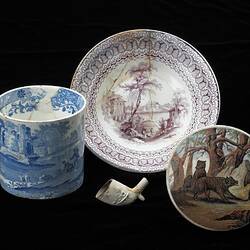Summary
This reconstructed saucer was excavated at the Commonwealth Block site between 1988 and 2003. There is a matching cup that was found with it. The pattern is known as 'Moss Rose' and was made between 1850 and 1851 by Charles Meigh, Son & Pankhurst in Hanley, Staffordshire, England.
Homewares.
Numerous crockery pieces were found all over the Little Lon site. Crockery gives us a glimpse of everyday life in Melbourne in the 1880s. In the houses around Little Lon, residents used decorated crockery. Most pieces were cheap earthenware or stoneware, yet provided colour and cheer. Only a few could afford to buy matching sets, and most china was probably acquired second-hand. Some were once expensive pieces. Householders mixed and matched their crockery from the great range of mass-produced designs available. 'Blue and white' and the 'willow' pattern, was the most popular choice and was produced by English potteries from 1790.
Physical Description
This glazed earthenware saucer has been reconstructed. It is decorated with a blue vine and leaf design around the rim, on the face there is a group of flowers.
Physical Description
Description for Parent Record: Tea cup and saucer - white with blue/black "viney/leafy" design around edge . Cup 95% complete, saucer(s?), 60%. Maker's mark on base of saucer: "MOS C.M.S. &..." - . Pattern name is 'Moss Rose'. It was made by Charles Meigh and Sons, Pankhurst, Staffordshire, 1850 - 1851.
More Information
-
Collection Names
-
Collecting Areas
-
Acquisition Information
Transfer from Heritage Victoria, Industry Superannuation Property Trust, 03 May 2005
-
Manufacture Name
-
Manufacture Date
-
Manufacturer
Charles Meigh, Son and Pankhurst, Hanley, Staffordshire, England, Great Britain, 1850-1851
-
Inscriptions
On base: 'MOS./C.M.S.& ..'
-
Context Number
02/22
-
Site
[CCS] Australia, Victoria, Commonwealth Block, Melbourne
-
Activity
-
Specific Activity
-
Decoration
-
Colour
Black
-
Moulding
Floral
-
Form
Plain Rim; No Well Body; Cylindrical Foot (Base)
-
Shape
Round
-
Technique
-
Provenance
England, Staffordshire
-
Classification
-
Category
-
Discipline
-
Type of item
-
Exhibition Collection Management
153 mm (Width), 70 mm (Height)
for cup and saucer; width = diameter
-
References
G. A. Godden 'Encyclopedia of British Pottery and Porcelain Marks', 1991
429 Pages
-
Keywords


